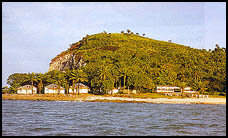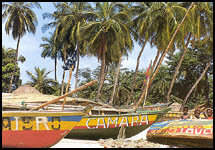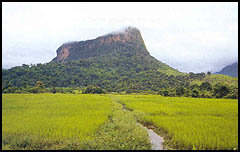 TOURISM: A HIDDEN TREASURE TOURISM: A HIDDEN TREASURE |

There are few definitions describing Guinea's incredible economic potential than " an industry without a chimnee ", a name given to Guinea by economists. It is in this sense that Guinea is turning. The recently appointed Minister of Tourism expresses clearly " the determination of the government to make this rich sector a real development tool ". according to Mrs Diakite, the Minister of Tourism, this opinon is shared also by the Minister of Finance, Mr. Cheick Amadou Camara, who underlines the fact that " the government must take the tourism industry seriously for future development ".

Guinea offers some of the most astonishing natural contrasts in the West African region: beaches bordered by palm trees on the atlantic coast, humongous waterfalls in the Fouta Djallon region, the savannah in upper Guinea and mountains such as Mount Nimba in the forest region. The country suffers from a lack of hotel infrastructure with only a total of 3115 rooms throughout all of Guinea and few apt professional to adapt the sector. the decree of march 25, 1998 regarding the national policy on tourism indicates that "the formation of professionals and the participation of the local peoples is a priotrity in the sector". the creation to the Federation of Tourism and Hotel employers, directed by its president Mr. Coumbassa, regroups all of the local operators "contributing to the execution of the strategic plan for the development of the tourism sector, by classifying, categorizing establishments and intervening with the administration in order to solve some problems that are posed to the hotel establishments." Basically, the will be the unifying force between the operators and the State, in order to organize the sector.
| 
Besides the beauty of the country, and its four natural regions, one of the main needs is the putting value and the conversion of 300 sites. The waterfalls of Kambadaga, of Sala or hose of the "brides vail" in Kindia, the fort at boke, the "knight garden", the waterfalls of the billage of Ditinn, the cliff at Dounky, the ladder of lelouma, the "women of Mali", the mosque at Dinguiraye, the "house of the governor" at dalaba, the islands of Loos or the city of Kerouane. These are a few of the sites that the government are focusing on and are well worth it. Right after the petroleum, the tourism sector is the second source of richness in the world. The impact of tourism is decisive for the development of certain countries as it can generate necessary revenues in almost any secot of an economy. In 1999 only less than 28000 tourists came to visit guinea and only a little more than 5500 came on vacation. There are around 20 travel agencies in Guinea, but the country is only represented internationally in its embassies, which only recently started a campaign to promote Guinea abroad. Guinea will be hosting the congressional meeting of the Africa Travel Agency in 2002. |

